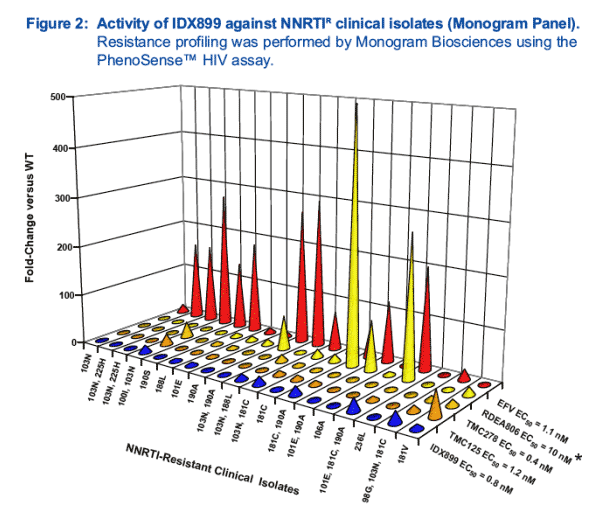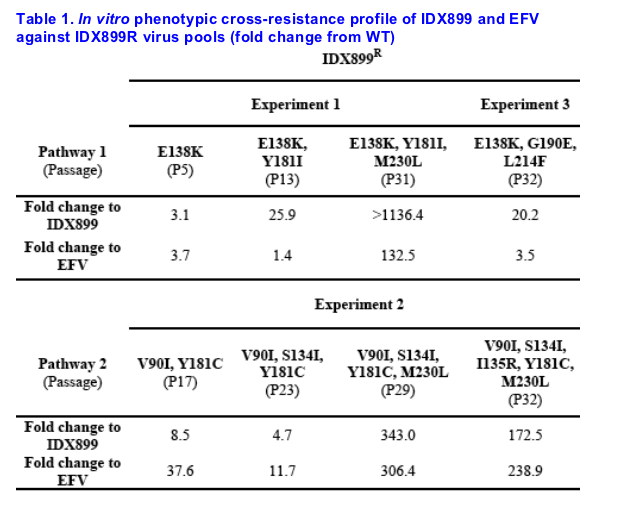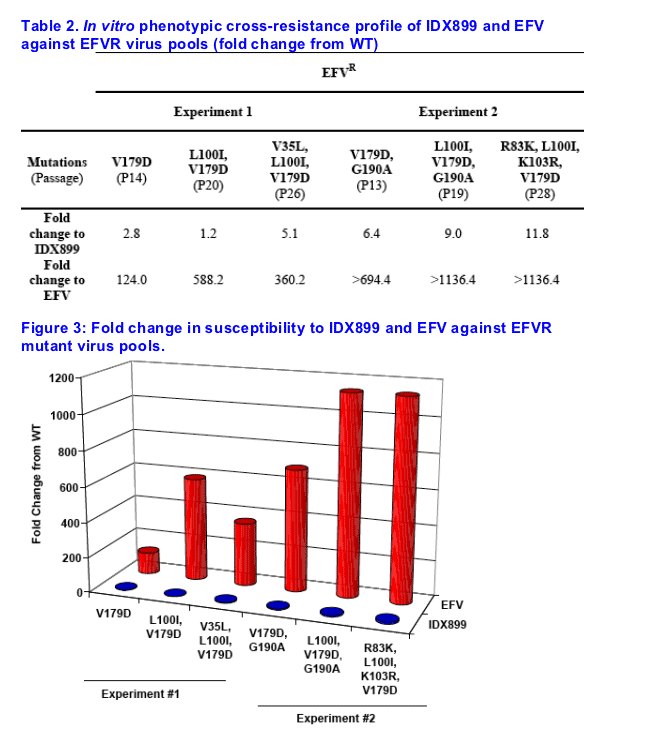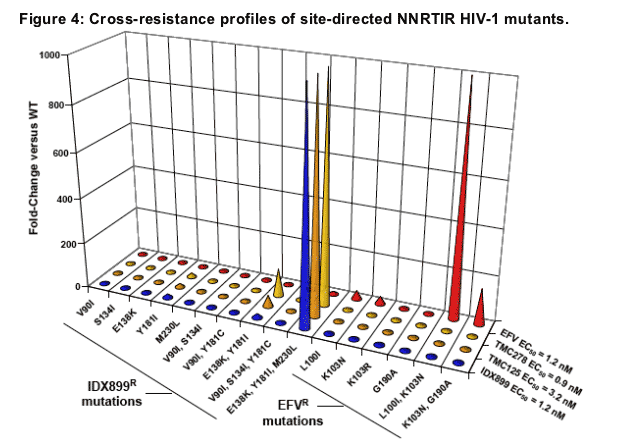 |
 |
 |
| |
Genotypic Resistance and Phenotypic Cross-Resistance Profile in vitro for a Novel NNRTI: IDX899
|
| |
| |
Reported by Jules Levin
15th CROI, Feb 3-6, 2008, Boston
DD Richman1, J Jakubik2, C Chapron2, L Hubbard2, L Gray2, M Seifer2 and DN Standring2
1University of California San Diego and VA San Diego Healthcare System, CA, USA; 2Idenix Pharmaceuticals, Inc., Cambridge, MA, USA
BACKGROUND
· Non-nucleoside reverse transcriptase inhibitors (NNRTIs) are valuable components of antiretroviral combination therapy for the treatment of human immunodeficiency virus type 1 (HIV-1)-infection.
· In treatment-naive patients, the most widely used NNRTIs are limited by a low genetic barrier leading to rapid emergence of drug-resistant mutants.
· IDX899 (see Figure 1) is a novel NNRTI drug candidate for the
treatment of HIV-1 infection with potent and selective in vitro antiviral characteristics.4
· Our data suggest that this compound may offer an enhanced resistance threshold with favorable pharmacokinetic and safety profiles, suitable for once-daily oral dosing in treatment-naive and NNRTI-experienced HIV-1-infected individuals.5
· IDX899 is currently in a proof of concept study in HIV-1 infected patients.
AUTHOR Conclusions & Discussion
· Compared to EFV, emergence of IDX899-resistant HIV-1 isolates in vitro was slower and required more mutations suggesting a higher barrier to resistance for IDX899.
· Two pathways to IDX899 resistance were identified in a panel of in vitro selection studies, one starting with the mutation E138K and the other with V90I.
· In vitro cross-resistance data imply that IDX899 has a different resistance profile than EFV and remains active against EFVR virus pools containing up to 4 mutations.
· Conversely, our studies suggest that IDX899-selected HIV-1 resistant virus pools bearing up to 3 mutations can remain susceptible to EFV. The significance of these in vitro findings will need to be established in clinical studies.

METHODS
Compounds
· IDX899, etravirine (TMC125), rilpivirine (TMC278) and efavirenz (EFV) were synthesized by Idenix Pharmaceuticals, Cambridge, MA.
Antiviral efficacy
· Activity profiles for IDX899, TMC125, TMC278 and EFV were generated using in vitro selected viral pools and site-directed mutants in the BH10 backbone.
Identification of IDX899R (resistant) mutants
· In vitro selection of drug-resistant variants was performed in HIV-1 BH10 WT infected MT-2 cells grown in escalating drug concentrations. Virus replication was monitored by syncytium formation indicative of viral breakthrough. Since pilot experiments showed that doubling of IDX899 concentrations after a single syncytial event led to loss of HIV-1 infection, drug concentrations were only doubled following two passages showing massive syncytium formation to ensure mutant survival. Emerging viruses were subjected to genotypic analysis via RT-PCR and population sequencing to identify the selected resistance mutations.
Phenotypic cross-resistance testing
· Performed using in vitro selection supernatant normalized to 75 ng of capsid antigen (p24) per million MT-4 cells.
· Contribution of each mutation to resistance was determined with site-directed HIV-1 (BH10 strain) NNRTI mutants.
RESULTS
Activity of IDX899 against a panel of NNRTIR clinical isolates
· IDX899 had potent antiviral activity against NNRTIR clinical isolates (n=19) in the PhenoSense™ assay (Figure 2).
· IDX899, TMC125 or TMC278 remained active against the bulk of the NNRTIR mutant panel implying a higher barrier to resistance than EFV.
· Based on data presented by Ardea Biosciences2 and summarized in Figure 2, IDX899 retained antiviral activity against more NNRTIR mutants than RDEA806.

*Ardea Biosciences Abstract #1662, 47th Annual ICAAC, Sept 2007
In vitro selection of IDX899R virus pools
· Resistance mutations selected with IDX899 differed from those selected with EFV.3
· A series of in vitro selection studies revealed two pathways to IDX899 resistance
(Table 1):
- Pathway 1 via E138K
- Pathway 2 via V90I
Antiviral efficacy of IDX899 and EFV against IDX899R virus pools
Virus pools selected by IDX899 were tested against each drug. Results are shown in
Table 1. The key findings can be summarized as follows:
· 26 to 30 passages and at least 3 mutations were typically required to produce virus pools with high level resistance [>100-fold] to IDX899.
· Virus pools containing V90I, S134I, Y181C and M230L mutations at passage 29
(Experiment 2) or E138K, Y181I and M230L mutations at passage 31 (Experiment 1) showed 343- and >1136-fold resistance to IDX899, respectively, and were also resistant to EFV.
· Virus pools tend to show higher levels of resistance than the equivalent site directed mutant viruses, presumably due to contributions from minor mutant species.

Antiviral efficacy of IDX899 and EFV against EFVR virus pools
· Mutant virus pools selected by EFV were tested against EFV and IDX899 (Table 2 and Figure 3).
· For EFV, one to four mutation(s) generated virus pools highly resistant to EFV, ranging from 124- to >1136-fold (Table 2).
· All EFV-resistant virus pools selected through passage 28 and carrying up to 4 mutations remained susceptible to IDX899 (<12-fold resistance).

Activity profile of IDX899 against site-directed mutants
· Site-directed mutant BH10 viruses were used to confirm the contribution of specific mutations to resistance.
· IDX899 demonstrated good antiviral efficacy (EC50 of ≦ 2 nM) against most (8/9) viruses containing NNRTIR single point mutations and was equally effective against most (4/5) viruses with two mutations (Figure 4).
· The M230L triple mutant virus was >1000-fold resistant to IDX899 as well as TMC125 and TMC278. A modulation role of M230I/L has been suggested.1

References
1. Brilliant J, Klumpp K, Swallow S, et al (2004). Antiviral Therapy; 9:S20.
2. Hamatake R, Zhang Z, Xu W, et al (2007). 47th Annual Interscience Conference on Antimicrobial Agents and Chemotherapy (ICAAC), Chicago, USA.
3. Jakubik J, Seifer M, Gray L, et al (2007). Antiviral Therapy 2007;12:S32.
4. Richman DD, Dousson CB, Storer R, et al (2007). 14th Conference on Retroviruses and Opportunistic Infections (CROI), Los Angeles, USA.
5. Mayers D, Hard M, Damphousse D, et al (2008). 15th Conference on Retroviruses and Opportunistic Infections (CROI), Boston, USA.
|
| |
|
 |
 |
|
|